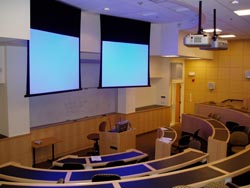Talking AV/IT

- A decade ago, the systems that integrators installed were all about the space and how it functioned. Today, with IP control and monitoring an industry standard, both the transport network and the control network form a link between systems integration and information technology.
Conferencing projects like this one at SUNY ESF by York Telecom involve a much higher participation of the IT shop, and the systems integrator needs to understand that.
"As conferencing has moved to managed services, our indication is that the client would like to schedule it in Outlook or Lotus Notes, walk into the room, and it's up," observed John Tisdale, vice president of strategic business development at visual communications solutions provider York Telecom in Eatontown, NJ. "In order to do that, we need to work with the IT shop to establish a control network." The increasing strength of this connection is pushing companies to seriously address the demands of both worlds: York Telecom, for example, acquired systems integration firm Univisions Crimson Group earlier this year.
One of the biggest issues that results from the collision of AV and IT is, of course, security. Service delivery centers tend to be outside the firewall, Tisdale points out, and installing systems on a secure IP network behind the client's firewall isn't always justifiable in economic terms. "I've got to establish some type of VPN connectivity from service delivery centers into the conference space. In order to do that, I've got several forces at play: the cooperative force that we have to do this together, but the other, of course, is security," he illustrated.
As the systems themselves communicate with one another, so, too, must integration and IT professionals. "It's a matter of defining the expectations early, getting the buy-in between the integration community, the IT community and the security community, and working through the rules of the game," Tisdale said.

The increasing strength of the connection between the AV and IT worlds is pushing companies to seriously address the demands of both to ease projects such as this space at the Tufts-Fletcher School, which was installed by York Telecom.
The convergence of AV and IT-and the collaboration between integrators and IT teams-is demonstrated at the MaRS Discovery District in the MaRS Centre in Toronto, ON, Canada. A not-for-profit corporation focused on marrying the country's scientific and technological innovators with business capital, the facility is equipped with an elaborate infrastructure, based on Harman HiQNet technology, that distributes audio and video over Cat-5 cabling only. MaRS enlisted Toronto-based integration firm Applied Electronics for the project.
"What we tried to do was bring in the disciplines of audio/video systems as well as the broadcast realm-traditional broadcast, which is not just using data network to distribute content, but it's also for being able to get from Point A to Point B using traditional network infrastructure," explained Robert Smith, technology consultant at MaRS Discovery District. To make this happen, Cat-5 became a critical component. "Having one type of cable plugged into the wall was really critical for us being because we didn't want to have to triple our investment by having coax cables, audio cables, video cables as well as data cables all going down to the same location."
To achieve this, the AV team had to start thinking like their counterparts in IT. "Really, the foundational element of what this new world if going to look like is about data networks, and software on servers or appliances. You install these devices for audiovisual purposes, but the real sizzle is how often the software is updated for new features, and what kind of protocols are being used that will allow devices to talk to other devices on the infrastructure," Smith said. "Old AV school people have to learn the same dictionary as the IT people, because then they can talk in a very similar, peer-to-peer way."
Smith, who spent the first half of his career working in the AV integration realm, believes that in order to take full advantage of the relationship that AV shares with IT, AV professionals must familiarize themselves with the IT lexicon, and deliver their own proposals in a manner that IT personnel can digest. "You are going to have to have reference materials; some sort of back-up to just saying, 'Well, if you don't do it this way, this will happen,'" he said. "Instead of trying to defend your position, you need to get as much resource material and reference accounts, and things that people have done in the past to really substantiate what you are saying."
Considerable effort must also be paid to translating systems contractor speak into terms that IT professionals understand. "Because they are converging, everyone is getting better at using acronyms, but maybe not fully understanding what the acronym means," observed Kevin Cleary, president of United Digital Integrators in Granger, IN. To address this, Cleary shows examples of how things work and how he believes they should be laid out. "I need to go the extra mile to make sure that my customers understand what I'm selling them, and making sure it matches their needs so they can present it to their bosses, superintendents, and CFOs in an adequate manner."
A daily selection of the top stories for AV integrators, resellers and consultants. Sign up below.
Carolyn Heinze has covered everything from AV/IT and business to cowboys and cowgirls ... and the horses they love. She was the Paris contributing editor for the pan-European site Running in Heels, providing news and views on fashion, culture, and the arts for her column, “France in Your Pants.” She has also contributed critiques of foreign cinema and French politics for the politico-literary site, The New Vulgate.
